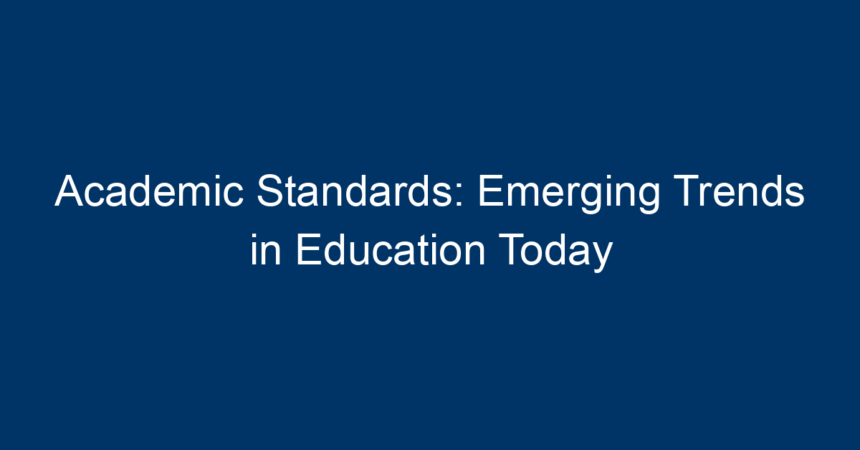In today’s rapidly evolving educational landscape, academic standards are at the forefront of discussions among educators, policymakers, and parents. As technology, pedagogy, and student needs change, academic standards are adapting to ensure students not only meet educational goals but also thrive in a global economy. This article delves into the emerging trends in education that are reshaping academic standards, providing insights on how these changes impact students and educators alike.
Understanding Academic Standards
Academic standards serve as benchmarks for what students should know and be able to do at each stage of their education. These standards are essential for ensuring that all students receive a quality education, regardless of their background or location. They are designed to provide a clear framework for educators, allowing them to assess students’ progress and tailor instruction accordingly.
Historical Context of Academic Standards
Historically, academic standards have focused on core subjects like math, science, and literacy. The goal has always been to prepare students for college and career readiness. However, as society continues to shift toward a more knowledge-based economy, the need for a broader set of competencies has emerged. Academic standards are now expanding to include critical thinking, collaboration, and digital literacy.
The Shift Toward Competency-Based Education
One of the most significant emerging trends in academic standards is the move toward competency-based education (CBE). Unlike traditional models that often prioritize seat time and rote memorization, CBE focuses on students’ ability to demonstrate mastery of skills and knowledge.
Benefits of Competency-Based Education
-
Personalized Learning: CBE allows for personalized educational pathways, enabling students to progress at their pace. This flexibility caters to diverse learning styles and needs.
-
Real-World Application: By emphasizing competencies, students are encouraged to apply their knowledge in real-world situations, ensuring a deeper understanding of the subject matter.
- Engagement: Students are more engaged when they see the relevance of their education, making learning more meaningful and enjoyable.
Implementing Competency-Based Academic Standards
For CBE to be successful, states and school districts are developing academic standards that clearly outline competencies in various subjects. These standards help educators design curriculum and assessment methods that align with desired outcomes. Collaboration among stakeholders—educators, administrators, and community members—is crucial for effectively developing and implementing these standards.
Integrating Technology in Academic Standards
With the rise of digital tools and resources, academic standards are increasingly incorporating technology. This trend is essential for preparing students for a technologically advanced workforce.
Digital Literacy as a Core Component
Digital literacy—including the ability to evaluate information, use digital tools effectively, and safeguard personal data—has become an integral part of academic standards. Educational institutions are now prioritizing digital skills across all subjects, ensuring that students are not only consumers of technology but also creators.
Blended Learning Environments
Blended learning, which combines traditional classroom instruction with online elements, is another trend gaining traction. This approach allows students to engage with content at their own pace while still benefiting from the guidance of a teacher. Academic standards are evolving to support this dual approach, emphasizing the need for both in-person and digital learning competencies.
Equity and Inclusion in Academic Standards
As discussions around educational equity intensify, academic standards are being revised to ensure inclusive practices are woven into the fabric of education. This trend recognizes that academic standards should serve all students, regardless of race, socioeconomic status, or ability.
Culturally Relevant Pedagogy
Culturally relevant pedagogy is an instructional approach that recognizes and incorporates students’ cultural references in learning. By embedding this into academic standards, educators can create more inclusive and engaging learning environments that resonate with all students.
Universal Design for Learning (UDL)
Another key element in promoting equity is the implementation of Universal Design for Learning (UDL), which focuses on creating flexible learning environments that accommodate individual learner differences. Academic standards that reflect UDL principles allow for diverse methods of engagement, representation, and expression, thereby supporting all students’ learning needs.
Assessment Innovations
As academic standards evolve, so too does the approach to assessment. Traditional forms of assessment, such as standardized tests, are being scrutinized for their limitations in measuring student learning comprehensively.
Formative and Authentic Assessments
Emerging trends in assessment focus on formative and authentic assessments. Formative assessments provide ongoing feedback to students, allowing them to gauge their understanding and improve over time. Authentic assessments evaluate students’ skills in real-world contexts, ensuring that they can apply what they’ve learned effectively.
Emphasizing Growth Over Proficiency
Another emerging trend in assessment is moving the focus from merely achieving a certain score to demonstrating growth over time. This shift in mindset encourages a more holistic view of student progress and fosters a growth-oriented environment where all students can succeed.
Professional Development for Educators
In light of these emerging trends, the need for ongoing professional development for educators is more critical than ever. As academic standards evolve, educators must be equipped with the skills and knowledge to implement these changes effectively.
Continuous Learning Opportunities
School districts are increasingly investing in continuous professional development programs that focus on pedagogical strategies, technology integration, and inclusive practices. By fostering a culture of continuous learning among educators, schools can better support the successful implementation of new academic standards.
Collaboration and Networking
Encouraging collaboration among educators through professional learning communities (PLCs) is another key trend. These networks provide opportunities for teachers to share best practices, resources, and experiences, ultimately enhancing the quality of education they deliver.
Concluding Insights: Embracing the Future of Academic Standards
The landscape of education is changing rapidly, and with it, the academic standards that guide teaching and learning. As we move toward a more competency-based, technology-integrated, and equitable approach to education, it’s crucial for educators, policymakers, and communities to collaboratively navigate these changes.
Actionable Steps for Educators and Stakeholders
-
Stay Informed: Regularly update knowledge on emerging trends in academic standards through professional development and educational resources.
-
Foster Inclusivity: Implement culturally relevant pedagogy and equitable practices to ensure that all students feel valued and supported.
-
Embrace Technology: Integrate digital literacy into curricula and adopt blended learning environments to prepare students for a tech-driven future.
- Collaborate: Engage with other educators and stakeholders to share strategies and resources, building a supportive network around academic standards.
By focusing on these actionable steps, we can work together to ensure that the evolution of academic standards leads to better educational outcomes for all students. The future of education is bright, and the adaptability of academic standards will play a pivotal role in shaping that future.
Embracing these emerging trends is not just about meeting benchmarks; it’s about fostering a more robust, equitable, and engaging learning environment for every learner. As we navigate these changes, let’s commit to creating a future where academic standards serve as a foundation for student success—today and tomorrow.




